Export markets are a solid channel for the Agrupación de Cooperativas Valle del Jerte, representing over 50% of its production.
After a season, that of 2022, characterized by severe losses, the organization based in Jerte places all its hopes in this season. Fruit Today spoke with Monica Tierno, general manager of the organization.
Can you give me an assessment of the past year, considering the effects of the storms?
The 2023 campaign will remain one of those campaigns etched into the memory of Jerte Valley farmers; one must go back to the year 88 to find a similar campaign. Undoubtedly, the level of damage, with over a week of uninterrupted rain on the dates when most of our campaign was concentrated, was disastrous, affecting both varieties in optimal ripening state and those about to ripen.
It was an unusual situation because normally, with our crops and cooperatives located at different altitudes and with different ripening calendars, when it rains, the harvest is always lost, but it usually only affects occasionally and not in a generalized way.
Last year we lost more than half of the expected harvest and, of what was harvested, not all was of sufficient quality to be commercialized, so we had to send much of it to the industry. The only thing that helped was the fact that there was a market context with very low supply because there was also damage in other production areas.
This caused market prices to remain higher than normal for the rest of the season, helping to reduce some of the economic losses, but of course, it is a season we would not want to repeat.
How did the weather conditions affect this year?
Pre-seasonal climatic conditions were favorable, both in terms of cold hours and precipitation. We are particularly pleased with the latter data, as in recent seasons we have had periods of lack of rain in spring, which turned into torrential rains in summer, damaging most of the harvest.
This year, however, precipitation was three times higher than the norm of recent years, and we hope this will soften possible future precipitations to reduce the risk of crop damage, although, as always, it is difficult to predict and impossible to control.
What are the predictions for the harvest?
We anticipate a medium season between 16,000 and 18,000 tons. We believe this will have a positive effect, provided the weather is favorable, in terms of better quality and size.
How are cherry exports developing?
Export is a very important channel for us. It represents between 50 and 60% of our turnover every year, both in the wholesale market and in sales to major supermarkets. Our customer portfolio is fairly stable, and we appreciate long-term business relationships. However, every year we have requests from potential customers interested in our brands, with whom we appreciate the opportunity to collaborate.
How were the Zalama and Jerteña brands received in the markets, and how was the first year of Jerteña's life?
Our Zalama brand is more than well positioned, and our customers appreciate us for being reliable suppliers of quality, continuity, and service. Jerteña went strong in the same direction, and in the first year, we have already managed to position it in markets where we still had growth opportunities, both nationally and for export.
We have paid a lot of attention to this brand; we like it to represent our values and highlight the role of Jerteña farmers, who are always present in our agriculture but not always visible. And, of course, the cherries packaged there are of the best quality, grown in mountain agriculture in a wonderful environment.
Have there been any new investments in ACVJ?
Yes, we are advancing our strategy of automation and digitalization. This season we will have a new 14-way optical grader, with built-in artificial intelligence, with the aim of increasing our daily production capacity and optimizing calibration and packaging processes with the latest technologies on the market to always ensure the best quality.
Source: Fruit Today
Image: Asociacíon Cerezas Valle del Jerte
Cherry Times - All rights reserved












